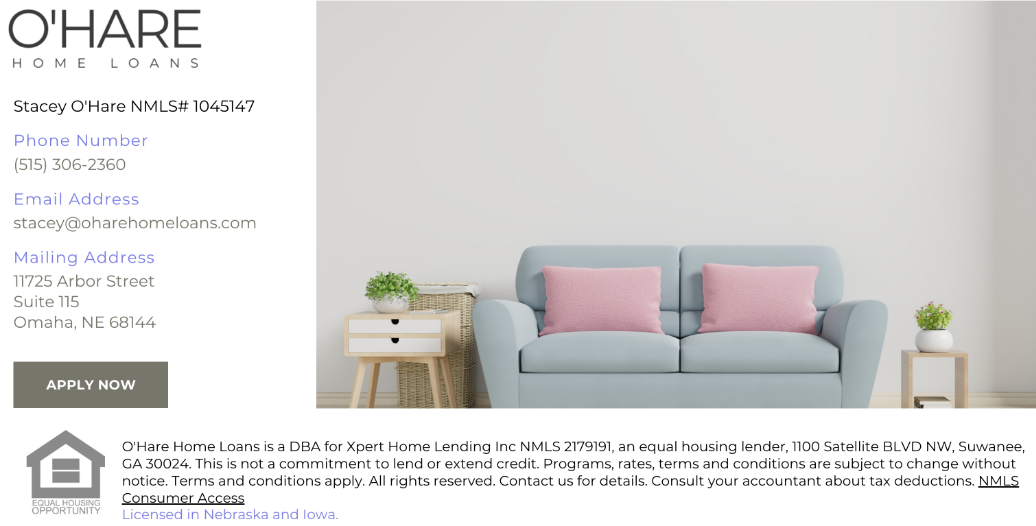Really? November is a Great Time to Buy a Home in Omaha!

The average person believes spring is the best time to buy a home. They imagine sunshine, blooming flowers, and competitive bidding wars that somehow seem more palatable when the weather is nice. But here's what we've learned after years of helping Omaha families find their perfect homes: November is one of the smartest times to make your move.
While everyone else is waiting for warmer weather, green grass and "better timing," savvy buyers are taking advantage of conditions that simply don't exist during the traditional spring rush.
What’s really happening in the Omaha market right now? How does the Omaha market in November 2025 present opportunities that you won't want to miss?
The competition has cooled off, and the numbers prove it. According to current Redfin data, homes in Omaha are now selling in about 21 days, down from 18 days last year. Now, you might be thinking, "Wait, isn't that worse?" Not if you're a buyer.
Those three extra days represent something crucial that the lady doesn't understand: breathing room. During last spring's buyer frenzy, you might see a home on Thursday, schedule a showing for Saturday, and discover by Sunday that it's already under contract with multiple offers. In November, you actually have time to think, schedule a second showing, bring your parents or a trusted friend, and make a decision that feels right rather than rushed.
Here's something even more interesting about today's Omaha Real Estate market: We found that nearly one in three homes currently listed in Omaha has had a price reduction. Houzeo reports that 30.4% of sellers have already lowered their asking prices. This alone is a dramatic shift from the "take it or leave it" attitude we saw during last year's and even last Spring's peak market conditions.
What does this mean for you? It means sellers are motivated, realistic, and ready to negotiate. When you walk into a conversation with a seller who's already acknowledged their initial price was too high, you're starting from a position of strength. This isn't about taking advantage of anyone; it's about fair market value finally catching up with asking prices.
The buyers who are out there looking in November aren't casual browsers. They're serious. They need to move. It could be a job relocation that can't wait until spring. They may have been transferred and need to be settled before the new year. They may finally be ready to stop paying rent and build equity instead. Whatever the reason, November buyers are committed, and sellers know this. When you submit an offer in November, sellers don't assume you're just testing the waters or comparing options. They know you mean business, which changes the entire dynamic of the negotiation.
Let's talk about motivation, because timing creates urgency. Sellers who list their homes in November or keep them on the market through the holidays are doing so for a reason. They're not casually thinking about moving; they need to move. They may have already purchased another home and are carrying two mortgages.
Maybe they relocated for work and have been managing an empty house for months. They may be facing a significant life change that requires liquidity. We don't know fdor sure. Whatever their situation, they're motivated in a way that spring sellers often aren't. Spring sellers can afford to wait for their perfect offer because they know another wave of buyers is right around the corner. November sellers don't have that luxury, and that works in your favor.
The holiday factor matters more than you think. Nobody wants to be showing their home during Thanksgiving dinner or Christmas morning. Sellers who are still marketing their properties in November are often hoping to close before the holidays.
Fear of Holiday disruptions creates a natural deadline that encourages realistic pricing and reasonable negotiations. We've found that you can make a seller's holiday season easier by taking their home off the market before juggling showings and family gatherings. In that case, you've got leverage, not in a manipulative way, but in a practical, everyone-wins negotiating way.
Closing before December 31st isn't just about timing; it's about money.
Buying and closing on your home before the end of the calendar year offers real financial benefits. Mortgage interest is tax-deductible, and if you close in November or early December, you'll have several weeks of mortgage interest to claim on your upcoming tax return. Property taxes paid at closing. Also deductible. Depending on your tax situation and the price of your home, these deductions could put hundreds of dollars in your pocket when you file taxes in April. Your CPA will thank you for thinking ahead, and you'll thank yourself when you see the difference in your refund or tax bill.
The inspection and appraisal process works better in late fall. When you think about it, it makes sense. home inspectors aren't slammed with back-to-back appointments. They can spend more time on your inspection, answer more questions, and give you better insights. Same with appraisers.
When they're not racing from property to property trying to keep up with spring demand, they can be more thorough and more accessible when you have questions. Even contractors who need to address repair issues have better availability. Suppose your inspection reveals that the furnace needs attention or the roof needs repair. In that case, you're much more likely to get competitive bids quickly in November than in May when every contractor in Omaha is booked solid.
Let's address the elephant in the room: winter weather concerns. Yes, you might be looking at home when there's snow on the ground. But here's what most people miss: winter conditions reveal things that perfect spring weather hides. You can see exactly how the home handles moisture, whether the gutters work correctly, if the driveway and sidewalks have drainage issues, and how well the windows and doors seal against cold. You'll know immediately if the furnace is adequate because you'll feel it. You'll see whether the home stays comfortable and warm or if you're constantly cold despite the heat running. These aren't problems; these are opportunities to gather information that spring buyers won't discover until months after they've moved in.
The inventory available right now includes homes from sellers who started listing in late summer and early fall. These aren't just leftover properties that nobody wanted. Many are quality homes from sellers who priced too aggressively at first and have now come back to reality.
Some are homes that went on the market in September or October when inventory was tight, and they're still sitting there waiting for the right buyer who isn't intimidated by the calendar. Current data shows Omaha has just 1.1 months of supply, indicating we're still in a competitive market, even during our traditional seasonal slowdown. The homes available now aren't abundant, but the buyers competing for them are fewer, and that changes your odds significantly.
Here's something we've noticed over the years of Omaha real estate: the homes that sell in November and December often represent exceptional value. This is because Sellers who keep their homes listed through the holidays have finally accepted that they need to price competitively to attract serious buyers and that their starting price when they entered the market was set too high.
They're not holding out for some magical offer that exceeds market value. They've done the math, considered their options, and priced their home to sell. When you're looking at homes in November, you're often looking at the best deals available in the entire market because the motivated sellers have naturally separated themselves from the ones who can afford to wait.
The paperwork and closing process feel less rushed when title companies and lenders have better availability. During spring, everyone in the real estate transaction ecosystem is stretched thin. Loan processors are handling multiple files simultaneously, title companies are scheduling closings back-to-back, and everyone is working overtime to keep up.
In November, these professionals have time to answer your questions thoroughly, catch potential issues early, and ensure a smooth closing. Your file isn't buried at the bottom of a stack of fifty, so you get the attention and service you deserve.
If you're worried about moving in winter, consider this perspective shift. Yes, driving in cold weather requires some planning. But you know what's harder? Trying to schedule movers during peak season when they're booked weeks in advance and charging premium rates. November movers have availability, competitive pricing, and flexibility. Plus, if you close in November or early December, you can move at a relaxed pace over several weeks, if needed, and get settled before the holidays rather than frantically unpacking between spring soccer games and school events.
Let's talk about mortgage rates for a moment. In our experience, your timing matters when it comes to mortgages. Experts expect the Federal Reserve to cut rates before mid-2025, which could push mortgage rates down into the mid-6 % range or lower.
But here's the reality: if you wait for rates to drop, you'll be competing with every other buyer who had the same idea. When rates improve, inventory depletes quickly as buyers flood back into the market. So If you buy now, you can always refinance later when rates drop. Still, you'll already be building equity and enjoying homeownership, rather than watching from the sidelines as prices climb amid increased demand.
One of the most significant advantages of November buying isn't about the market at all; it's about you. When you're not rushing to compete with dozens of other offers, when you have time to think through your decisions, when you can actually sleep on a choice before making it, you make better decisions. You notice things during that second or third showing that you missed the first time. You have conversations with your partner or family that aren't pressured by artificial deadlines. You work with your lender to explore different loan options instead of just taking the quickest approval. November gives you the gift of thoughtful decision-making, and that's worth more than most people realize.
The emotional aspect of home buying changes when you're not fighting for every property. Spring buying can feel exhausting and discouraging. You fall in love with a home, write a firm offer, and lose to someone who waived inspections or offered $20,000 over asking. After a few rounds of this, buyers become either desperate or defeated. Neither is a good state of mind for making the most significant financial decision of your life.
Clients have told us that buying in November feels different. When you find the right home and write a fair offer, there's a reasonable chance the seller will accept it. You can negotiate inspection issues without fear that another buyer is waiting in the wings to snatch the property. You can maintain your standards and boundaries because you're not operating from a place of scarcity.
We've watched Omaha's cyclical market patterns in the past few years, and November produces success stories that surprise people every year. We've helped families find amazing homes in excellent neighborhoods that were overlooked during the summer rush simply because buyers assumed "all the good homes were gone."
We've seen first-time buyers able to afford a home because the competition wasn't driving prices beyond reasonable levels. We've negotiated deals that included seller-paid closing costs, home warranties, and repair credit concessions that would have been laughed at during peak season.
The ugly truth about real estate is that the calendar doesn't determine the "best" time to buy; it's determined by your circumstances, and the market conditions you face at the time.
We feel that November 2025 presents market conditions that genuinely favor buyers in ways that spring 2026 likely won't. If you're ready to buy, if you've got your financing in order, if you've been thinking about making the move from renting to owning or from your starter home to something larger, the data supports it, the market conditions confirm it, and the experiences of savvy buyers who've made this choice prove it.
Here's what we recommend: don't let conventional wisdom about spring being the "right" time to buy convince you to wait when opportunity is knocking right now. The Omaha market isn't going to get dramatically more favorable in the next few months. When spring arrives and rates potentially drop, you'll be competing with everyone who waited. That competition will drive both prices and stress levels up. The homes available now might not be available then. The sellers who are motivated today might have pulled their properties off the market by March. The negotiating power you have this month could evaporate by May.
Think about where you want to be in six months. Do you want to be settled into your new home, hosting friends and family in your own space, building equity with every mortgage payment? Or do you want to be still looking, still waiting, still hoping that the perfect moment arrives?
November might not feel like the "perfect" time on the surface. Still, when you look at the actual advantages—less competition, better negotiating power, motivated sellers, tax benefits, professional availability, and the breathing room to make good decisions—it all starts looking pretty good.
For many years, The Heim-Berg Team has been helping Omaha families win in similar markets through all seasons, and we've learned that your real estate success isn't about timing the market perfectly. It's about understanding the conditions you're facing and using them to your advantage.
Right now, in November 2025, those conditions favor buyers who are ready to act. We're here to help you understand what's available, what's realistic, and how to position yourself for success, whether you're a first-time buyer or a seasoned homeowner making your next move.
Don't let the calendar intimidate you. Let the market data inform you, let the current conditions empower you, and let experienced advisors guide you. November is here, opportunity is real, and the home you've been dreaming about might be waiting for you right now—while everyone else is making excuses about the weather.
Ready to explore what's available in Omaha right now? The Heim-Berg Team knows this market inside and out because we live and work here every day. We track statistics and market data and create success stories for buyers who understand that opportunity doesn't always arrive on a perfect spring day. Let's talk about your goals, your timeline, and how we can help you take advantage of the very real benefits of November buying.
Contact The Heim-Berg Team:
Phone: (402) 677-9024
Web: https://www.omahaarealiving.com/
Your Omaha Real Estate Experts—Helping You Make Smart Decisions in Every Season


















